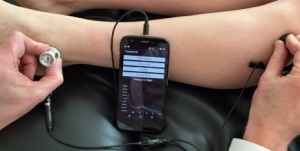by
Lauren Dubinsky, Senior Reporter | June 17, 2016

FractureDx prototype being
used on the fibula
X-ray imaging is the standard for diagnosing fractures, but that may one day be replaced with a less expensive approach that doesn’t use radiation. In a new pilot study, ScanDx’s FractureDx smartphone app has been shown to be as accurate as plain film X-rays when diagnosing foot and ankle fractures.
FractureDx uses an acoustic-based technique to assess bone integrity. Since the beginning of the 20th century, sound waves have been used to differentiate normal from fractured bones, but mostly only at sporting events or in remote locations.
Since a point-of-care tool wasn’t available yet, clinicians resorted to X-ray exams, bone scans or CT scans. But due to the high rate of overutilization, increasing health care costs and risks that radiation exposure poses to patients and clinicians, an alternative option is needed.



Ad Statistics
Times Displayed: 58694
Times Visited: 1817 Ampronix, a Top Master Distributor for Sony Medical, provides Sales, Service & Exchanges for Sony Surgical Displays, Printers, & More. Rely on Us for Expert Support Tailored to Your Needs. Email info@ampronix.com or Call 949-273-8000 for Premier Pricing.
ScanDx has developed a proof-of-concept prototype that is able to accurately detect fractures in bovine, porcine and avian specimens. The prototype consists of a smartphone, microphone with a stethoscope attachment, and a single bone-conducting headphone.
For the pilot study, six trauma patients from Penobscot Community Health Center in Maine were assessed with FractureDx. All of the patients had a standard clinical work-up and treatment involving X-rays as well.
Their right and left limbs were tested and compared to determine the presence or absence of a fracture. If the total vibrational energy varied more than 3.5 dB/Hz between the two sides, the side with the lower value was diagnosed with a fracture.
Five of the patients had fractures that were confirmed with X-ray exams and correctly diagnosed by FractureDx. The sixth patient had a contusion which the FractureDx, correctly, did not diagnose as a fracture.
The sample size was too small to deem the results statistically significant, but the study’s author and CEO of ScanDx, Dr. Todd O’Brien, will conduct studies involving more patients, and expects to see the same results.
Another drawback of the study was that the prototype required comparison test measurements between the two limbs, which could lead to variability. The future version is expected to use a reference database of normal bone signals to compare with the injured limbs.

